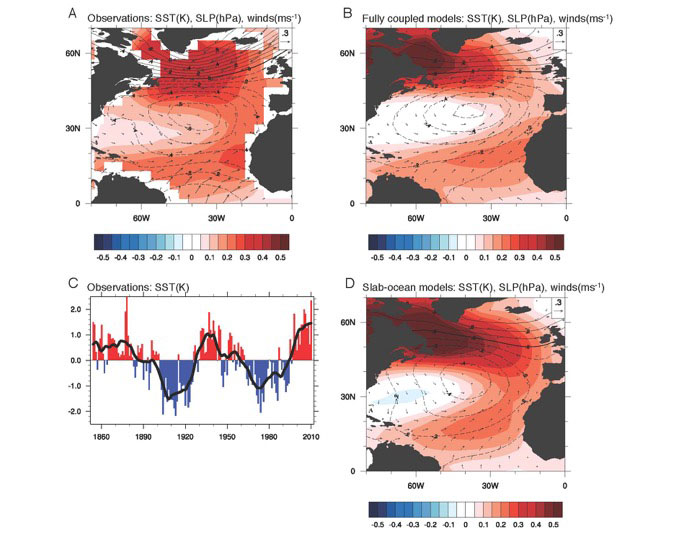A University of Miami (UM) Rosenstiel School of Marine and Atmospheric-led study challenges the prevailing wisdom by identifying the atmosphere as the driver of a decades-long climate variation known as the Atlantic Multi-decadal Oscillation (AMO). The findings offer new insight on the causes and predictability of natural climate variations, which are known to cause wide-ranging global weather impacts, including increased rainfall, drought, and greater hurricane frequency in many parts of the Atlantic basin.
For decades, research on climate variations in the Atlantic has focused almost exclusively on the role of ocean circulation as the main driver, specifically the Atlantic Meridional Overturning Circulation, which carries warm water north in the upper layers of the ocean and cold water south in lower layers like a large conveyor belt.
“The idea of the ocean as the driver has been a powerful one.” said UM Rosenstiel School Professor Amy Clement, the lead author on the study. We used computer models in a new way to test this idea, and find that in fact there is a lot that can be explained without the ocean circulation.”
While the overall rise in average temperature of the Atlantic is caused by greenhouse gases, this study examines the fluctuations occurring within this human-related trend. Identifying the main driver of the AMO is critical to help predict the overall warming of the North Atlantic Ocean in coming decades from both natural and man-made climate change. Recent research suggests that an AMO warm phase has been in effect since the mid-1990s, which has caused changes in rainfall in the southeastern US, and resulted in twice as many tropical storms becoming hurricanes than during cool phases.
Using multiple climate models from around the world, Clement’s research team removed the ocean circulation from the analysis to reveal that variations in the Atlantic climate were generally the same. The AMO results in a horseshoe-shaped pattern of ocean surface temperatures in the North Atlantic Ocean that have been naturally occurring for the last 1000 years on timescales of 60-80 years. This new analysis shows that the pattern of the AMO can be accounted for by atmospheric circulation alone, without any role for the ocean circulation.
“These results force us to rethink our ability to predict decade-scale temperature fluctuations in the Atlantic and their associated impacts on land. It may be that many of the changes have limited predictability, which means that we should be prepared for a range of climate outcomes associated with global warming,” said Clement.
The study, titled “The Atlantic Multidecadal Oscillation Without a Role for Ocean Circulation,” was published in the Oct 16 issue of the journal Science. The co-authors include Clement, Katinka Bellomo and Lisa N. Murphy from the UM Rosenstiel School; Mark A. Cane of Lamont-Doherty Earth Observatory of Columbia University; and Thorsten Mauritsen, Gaby Rädel and Bjorn Stevens from Max Planck Institute for Meteorology in Germany. The work was support by grants from the Department of Energy and the National Oceanographic and Atmospheric Administration.

This figure shows the characteristic 'horseshoe' pattern of Atlantic climate variability (top left panel), along with the time history of this pattern (bottom left). Most previous studies attribute this to changes in the ocean circulation. Our study compares climate models that include ocean circulation (top right) with climate models that have no ocean circulation (bottom right). The two are almost indistinguishable, indicating that the ocean circulation may not play as prominent a role as previously thought.
Credit: Katinka Bellomo, Ph.D, University of Miami Rosenstiel School of Marine and Atmospheric Science

